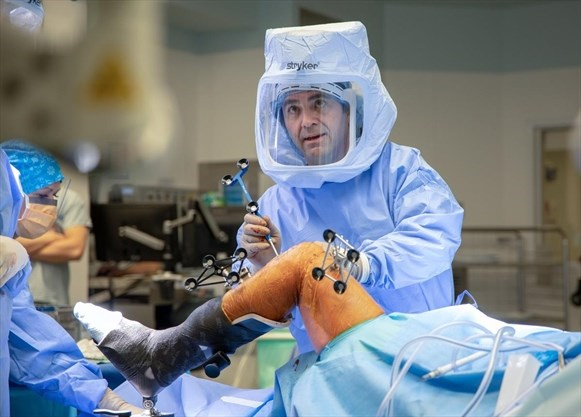Need a knee replacement? St. Joseph’s Healthcare has a robot that does that
St. Joe’s will do research to prove the technology works to avoid pitfalls plaguing robotic prostate cancer surgery.
Feb 25, 2019, by Joanna Frketich The Hamilton Spectator
Canada’s first knee replacements by a doctor-controlled robot have taken place at St. Joseph’s Healthcare as part of a study to prove the effectiveness of the technology and avoid the ongoing funding pitfalls plaguing prostate cancer surgery.
The robot has been used in four knee operations since Jan 18 in a pilot study funded by hospital donors.
“It’s very fledgling,” said Dr. Anthony Adili, who did the surgeries. “We’re just starting down a very exciting path … At the end of the day I think patients will benefit immensely from this new technology.”
St. Joseph’s, which specializes in robotic surgery, is getting the proof it needs from the start to show the technology is worth the extra cost so it doesn’t end up embroiled in the same dispute it faces with prostate cancer surgery.
“We’re in a golden opportunity to do that kind of pivotal research to inform our decision-making,” said Adili, chief of surgery at St. Joseph’s. “The research is being done (elsewhere) but it’s not high quality research so it’s hard to make definitive decisions and definitely difficult to make policy decisions. We want to produce that high quality data.”
The research is significant because a lack of evidence was behind a controversial recommendation in 2017 by the Ontario Health Technology Advisory Committee (OHTAC) against publicly funding robotic surgery to remove a cancer patient’s prostate gland.
It was a stunning blow to St. Joseph’s, where the vast majority of radical prostatectomies are done with the help of the da Vinci robot system.
Currently, the province pays the hospital the same price as the traditional operation and donors make up the extra cost of the robot. It’s an increasing burden on the St. Joseph’s Healthcare Foundation as the robot is rapidly becoming the surgery of choice with men from Kitchener to Niagara willing to travel and wait longer to get it.
A final decision on whether the province will eventually fund the robot for prostatectomies at an estimated cost of $800,000 — $3.4 million a year has been put off while St. Joseph’s gathers evidence on how it saves the health care system in other ways, such as a faster recovery time, since it’s no longer possible to do randomized trials.
“It’s so ubiquitous and it’s almost the standard of care,” said Adili. “It’s impossible to randomize someone to robotic prostatectomy versus an open prostatectomy. Nobody will go for it. We lost that opportunity.”
Orthopedic robotic surgery was approved in Canada and the United States only in the last year so high-quality studies can still be done. It’s the same for robotic thoracic cancer surgery with St. Joseph’s already running a multicentre trial.
“We don’t know who it’s going to benefit so we can do these randomized trials and develop that data that will help drive decision-making,” said Adili.
The biggest roadblock is that St. Joseph’s is the only centre in Canada doing robotic orthopedic surgery, making a multi-site trial of thousands of patients impossible to do here. With a price tag of $2 million a robot, it will be hard to find other centres with the appetite to join in.
“We’re going to have to partner with centres in the United States and convince them to contribute data,” said Adili. “The problem is they are buying robots like crazy because it is driving their business. They are going to be less inclined to want to randomize one versus the other. Some of our progress will be hampered until we get more units in Canada because Canadians have a very different mindset and will participate in trials.”
In the meantime, St. Joseph’s has started the pilot study that it hopes will provide enough evidence to get grants for the eventual large trial.
It’s important because Adili says one in five patients are currently unhappy with the outcome of their knee replacement and the robot’s precision could drop that number substantially. In addition, it makes partial knee replacements much easier, so surgeons will be more likely to do them.
“By replacing just the bad part of the knee, I’m leaving more of the patient’s normal anatomy behind,” said Adili. “It should feel like a more normal knee, recovery should be quicker and they should have better functionality. A total knee, although it is a successful procedure, it still does not match the mechanics of a normal knee.”
With the popularity of the robot for prostate cancer, Adili doesn’t expect any difficulty in recruiting patients.
The first was 66-year-old Peter Sporta from Oakville, who waited an extra two months to get a robotic partial knee replacement on Jan. 18.
“I wasn’t scared at all” Sporta said about being the first patient. “I couldn’t wait.”
Sporta was in the hospital for one night and walking the next day.
“Within three days I threw away my crunches and my cane,” he said. “For sure I would recommend this.”

